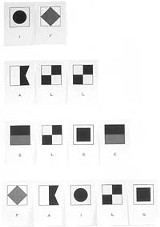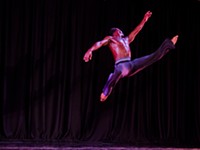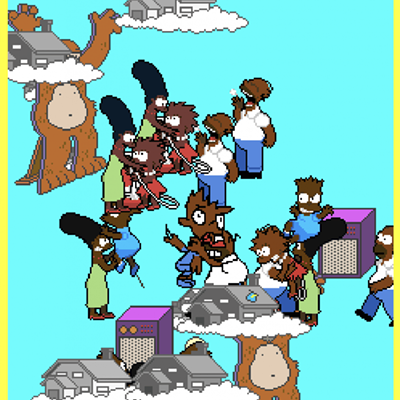[
{
"name": "500x250 Ad",
"insertPoint": "5",
"component": "15667920",
"parentWrapperClass": "",
"requiredCountToDisplay": "1"
}
]
The View From Here: Contemporary Russian and American Screenprints, an exhibition dedicated to printmaking, is definitely one you can sink your teeth into. The exhibition consists of screenprints by 22 artists --- 12 Russian and 10 American --- with a total of 70 works between them.
The differing artists' styles are brought together through the Hand Print Workshop International, which began as a partnership in Moscow and is now based in Virginia. Individual artists from both countries worked closely with master printmakers. It's usually a learning experience for both: Artists get to see their work in a different medium while the printmaker gets to push the boundaries of the print medium to accommodate the artists' vision.
What has come together at the Memorial Art Gallery is a sophisticated example of these collaborations. The exhibition is a smaller version of an exhibition that opened in Moscow in 2000 and concentrates on artists dealing with the societal-global changes since the fall of the Soviet state. While some of these concerns --- such as war, freedom, and artistic expression --- transcend national boundaries, others --- race, ethnicity, government, and art institutions --- are more society-specific. The literal, profound differences between the two countries are some of the most intriguing aspects of this exhibition.
For the American artists in the exhibition, there is the sense of an artist that observes the world from the outside --- but the American artist is also part of that world, part of the society at large. In Life in the Time #2, Robert Heinecken juxtaposes images from the media of glamour with war images to point out how these images, when separated, seem to be given equal value in our culture. The juxtaposition makes their differences evident.
Meanwhile, a Russian artist must always an individual outside the system (even if that's impossible in reality). Alexander Brodsky, in The Palace for Everyone's Prosperity, creates a vision of an architectural space that is vast, absurd, dark, and, at the same time, poetically beautiful. Is he questioning the promises of wealth for all? Or does the prosperity lie in Brodsky's freedom to produce such intricate and time-consuming work in the first place?
Unlike in the United States, where artists are often seen as agents of freedom of expression, in Russia, and especially during the Soviet era, an artist had a prescribed social function dictated by the state. This disparity remains --- you can even see it in the exhibition title.
The "here" in The View from Here implies, as it does in the Russian title, the view of the artist. But in English it can also imply a collective or broader "here," such as a nation. The Russian title literally translates into "personal view" and really stresses the individual --- his or her viewpoint, opinion, even personal appearance.
The question is whether any of this actually can be seen in the works themselves. The answer? Yes --- but not easily.
Art has supposedly become a global language. Modernism, the avant-garde, experimentation, conceptualism --- all distinguishing characteristics of contemporary art --- prevail across borders. Only upon closer examination are certain distinctions revealed, and even then they're blurry.
For example, a screenprint by American artist Carrie Mae Weems consists of four rows of iconic signal flags. Underneath each is a letter. Together, the flags represent (and spell out) the phrase, "If all else fails," which is also the title of the piece. How do you read a work like this?
For starters, the colorful pennants are reminiscent of the work of the Russian avant-garde of the 1910s, particularly the work of Kasimir Malevich. But, by adding letters to make words, is Weems implying that words make the otherwise abstract readable? Is this a gesture addressing the opaqueness of language?
Better yet, if we consider the context of Weems work, that it frequently addresses the issue of prejudice, especially racial prejudice, then the words "if all else fails" could be taken as a desperate call to action.
This attempt at readability typifies much of the work of the American artists in the exhibition. The Russian artists, however, seem more obscure, more metaphoric. Once you clue into the language of contemporary art, the work by American artists becomes, quite literally, readable. The Russian artists, however, and although using the same contemporary devices, give us work that defies an answer in any direct or logical way.
Vera Khlebnikovas 2000 Stamps consists of 2000 Russian pre-revolutionary stamps that represent different Russian czars. Khlebnikova found the stamps, enlarged them, and now presents them in a way that is reminiscent of Warhol's soup cans. You can certainly read the work as an exploration into popular culture; but, like Weems' work, if placed into the right (i.e. her particular) social context, Stamps takes on a different meaning.
Images of the czars would have been something that the Soviet state would not have allowed. Thus, presenting a wall of czars becomes both a subversive act and a connection to Russia's pre-revolutionary history, something that has been erased in Soviet history books. If that weren't enough, the stamps have been cancelled by the post office. All the marks are different and unique, just like the marks of an artist.
But just when we think we got it, those stamps, as pointed out in an essay in the exhibition catalogue, also could be associated with a childhood story of a kitchen woman who appears at a masquerade ball wearing a gown made of postage stamps. She's a character in a popular children's book, one that Khlebnikova probably read as a little girl.
Given the specific experiences that inform all these works, maybe we're not meant to understand after all.
You should go if you're interested in printmaking, contemporary art, or the role of the artist in society.
The View From Here: Contemporary Russian and American Screenprints through June 27 at the Memorial Art Gallery, 500 University Avenue. Gallery hours: Wednesday 10 a.m. to 4 p.m., Thursday 10 a.m. to 9 p.m., Friday 10 a.m. to 4 p.m., Saturday 10 a.m. to 5 p.m., and Sunday 12 to 5 p.m. $7 adults, $5 students and seniors, $2 Thursdays 5 to 9 p.m. 473-7720, mag.rochester.edu.
Latest in Art
More by Alex Miokovic
-
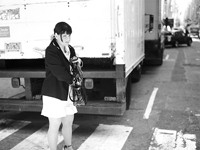
Larry Merrill at M. Early Gallery
Dec 6, 2006 -
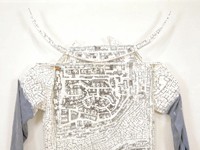
"Kim Jones: A Retrospective"
Nov 29, 2006 -
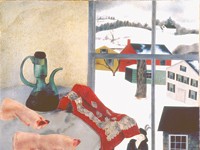
"My America" at the MAG
Nov 8, 2006 - More »
More by Heidi Nickisher
-

Larry Merrill at M. Early Gallery
Dec 6, 2006 -

"Kim Jones: A Retrospective"
Nov 29, 2006 -

"My America" at the MAG
Nov 8, 2006 - More »
